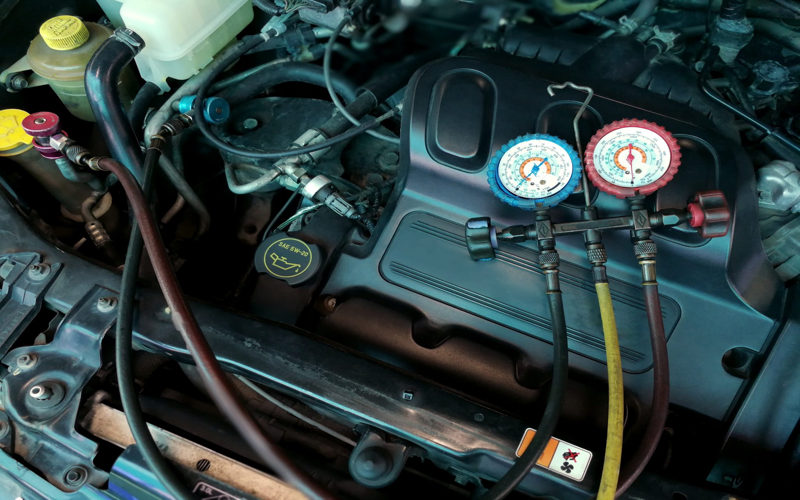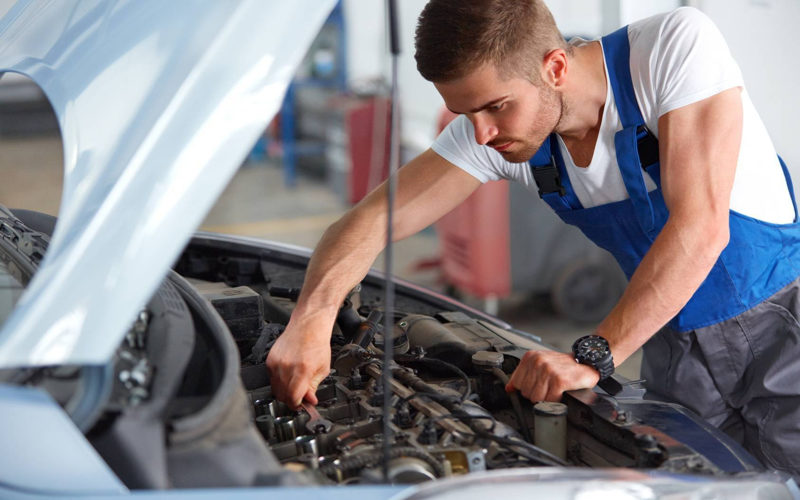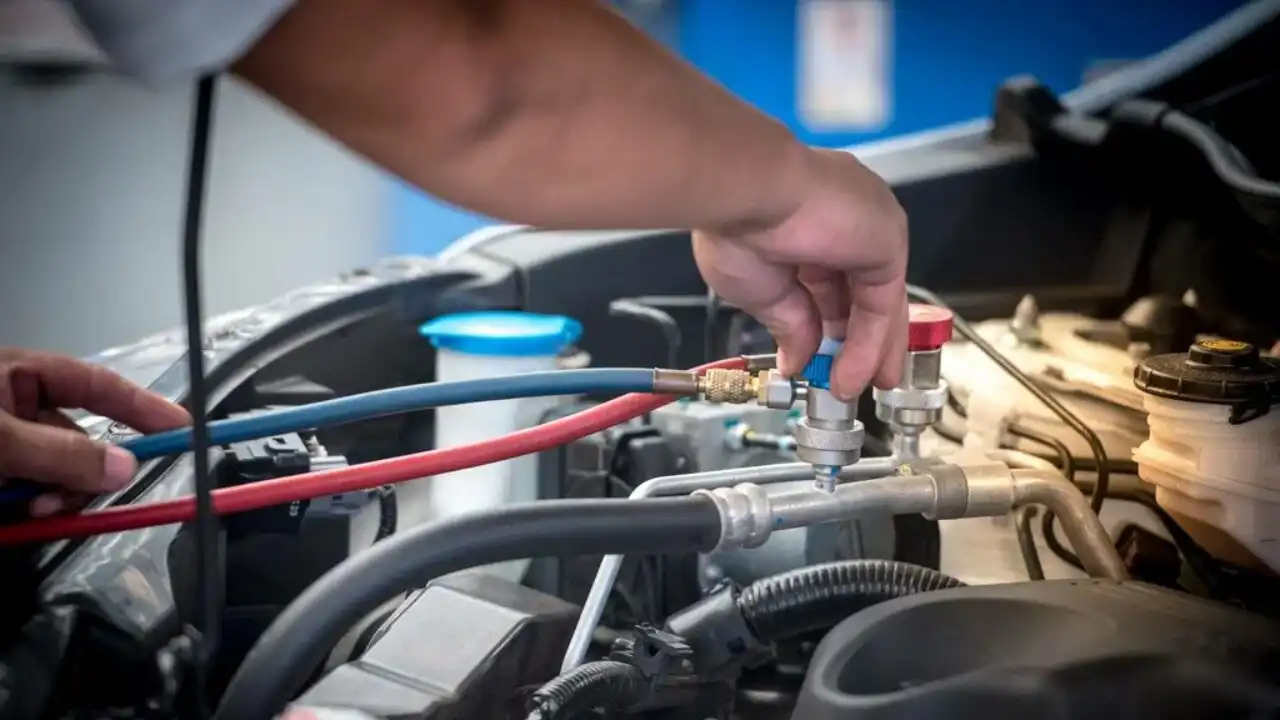It’s a hot summer day, you get in your car, and turn the AC on high blast, but only hot air comes out. An underperforming or broken air conditioner can make driving quite unpleasant. Before calling a mechanic, there are a few easy things you can check yourself to determine the cause. This article provides six tips for diagnosing common car AC issues and deciding if you can fix it or need to take it to a professional.
6 Ways To Diagnose The AC Problem
-
Inspect the AC Compressor
- Feel the AC Lines and Fins
- Check Refrigerant Levels
- Listen for Odd Noises
- Check Drive Belts
- Ensure Proper Airflow
Inspect the AC Compressor
 The air conditioning compressor is the heart of the AC system. It circulates refrigerant through the system’s components to produce cold air. If the compressor is not running, the AC won’t blow cold air. Here’s how to check the compressor:
The air conditioning compressor is the heart of the AC system. It circulates refrigerant through the system’s components to produce cold air. If the compressor is not running, the AC won’t blow cold air. Here’s how to check the compressor:
- Turn the AC on to max and open the hood with the engine running.
- Locate the AC compressor, usually near the front center of the engine bay. It looks like a small pump with belts or pulleys on it.
- Check if the pulley on the compressor is spinning. If not, there could be an electrical or mechanical issue preventing the compressor from engaging.
Feel the AC Lines and Fins
As refrigerant flows through the AC system, the various components should feel cool or cold to the touch with the AC switched on. Here’s what to check:
- With the engine and AC running, feel along the two AC lines running to and from the firewall. Both the low-pressure (larger diameter) and high-pressure (smaller diameter) lines should feel cool.
- Similarly, the AC condenser fins (in front of the radiator) and evaporator inside the cabin should have cold air blowing on them. If no components feel cool, there may not be sufficient refrigerant flow due to a leak or blockage.
Check Refrigerant Levels

If the compressor is engaging but the AC lines or components aren’t cooling down, low refrigerant is the most likely culprit. Here’s how to check:
- Obtain an AC gauge set from your local auto parts store.
- You have to attach the gauges, usually found near the firewall or compressor.
- With the car and AC running, note the pressure readings. Typical readings will be around 30 psi on the low/large line and 200 psi on the small/high line.
- If pressures are very low, say under 20 and 100 psi respectively, the system is undercharged and likely has a small leak allowing refrigerant to escape. Recharging the system yearly can compensate for small leaks.
Listen for Odd Noises

Unusual noises when engaging the AC compressor can indicate mechanical issues:
- Turn the AC to max, open the hood, and listen around the compressor.
- Listen for sounds like squealing, grinding, clicking, or squeaking. These noises usually signify an internal compressor failure.
- A loud hissing or gurgling points to a major refrigerant leak.
- Have a mechanic inspect any questionable noises right away before permanent damage occurs.
Check Drive Belts
The AC compressor and other components run via belts driven by the engine crankshaft. Issues like a snapped or loose belt can impact AC function:
- Open the hood and visually inspect all drive belts for cracking, fraying, or other damage.
- Gentle press each belt, checking for proper tension. Tight belts will have almost no play when pressed. The compressor belt should be snug.
- Worn or loose belts that allow slipping will mean erratic or lack of AC function. Replacing belts is an easy DIY fix.
Ensure Proper Airflow
For the AC to work correctly, sufficient airflow must pass over the chilled evaporator coils. Here is how to check for airflow restrictions:
- Make sure the cabin air filter is clean and clear of debris to allow air passage.
- Check that air intake vents under the hood are not covered or blocked by objects.
- Test AC vent strength around the cabin to feel if ample cooled air is distributed. Weak airflow indicates an obstruction in the vents or a failed blower motor.
When to Take Your Car to the Auto Garage

While many common car air conditioning problems can be diagnosed with simple at-home checks, certain issues require handing things off to a professional technician. You can start searching for car AC repair near me on the internet to get access to some of the best workshops, Determining the right time to enlist a repair shop ensures faults get properly fixed before leading to bigger problems down the road.
Electrical Gremlins
If the AC compressor clutch doesn’t engage even though the system is on, there may be a problem with the electricity. Failures in parts like the AC pressure sensor, the compressor clutch switch, or a number of blown fuses can stop the unit from turning on.
Electricity problems can be hard to find, so it’s best to have a trained professional check for things like broken monitors or shorted wires. They have the blueprints and connector diagrams they need to check every part of the AC circuit in a planned way.
Refrigerant Leaks
For a long time, small leaks can let the coolant slowly escape from the AC system. Recharging the refrigerant once a year can often fix small leaks. But if you think there is a big leak because the system pressures are so low, you need to fix it right away to keep the refrigerant from escaping completely.
AC repair experts have electronic leak detectors and sniffer tools that they can use to find the exact source of leaks that are hard to find just by looking. After that, they can fix any cracks or worn seals without having to restart the whole system.
Damaged Internal Components
If you hear grinding noises, chunks of metal, or debris coming from the AC compressor clutch, chances are some internal parts have become damaged or worn out. Compressors and other components like the expansion valve and evaporator contain intricate moving parts and seals.
Once failure occurs, replacing the entire component is usually necessary. Attempting to open these sealed parts often requires specialized tools and risks further damaging them. It’s more prudent to install new or professionally re-manufactured parts to get your AC back to peak function.
Contaminated Systems
Over time, metal particles and moisture buildup from internal wear can affect the oil and refrigerant that flow through an AC system. This causes things to rust, foul, and break down. Instead of having to rebuild the whole AC system, a technician can completely flush out the dirty fluids and refrigerant and replace them with new oil and lubricants to save parts. They use a special machine to safely catch, evacuate, and recharge the system after it has been cleaned. This is not something that you can do yourself!
While a few basic at-home checks can resolve minor AC problems, it’s best to hire a professional auto air conditioning technician from Auto Garage for electrical issues, major leaks, internal damage, or serious contamination issues. Investing in quality AC repair provides reliable summer comfort during hot drives for years to come.
Conclusion
Observe visual and audible compressor operation, feel system components for adequate cooling, check refrigerant levels and belts, and listen for odd noises to self-diagnose your car’s AC issues before resorting to the repair shop. While some problems can be DIY fixes, major issues are best left to qualified technicians. Stay cool out there!
Read more: Ideal Temperature for Car AC in Dubai










